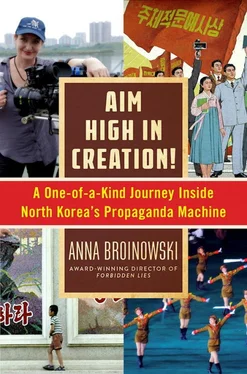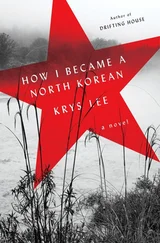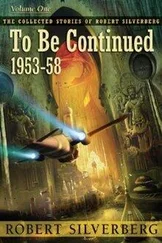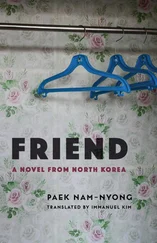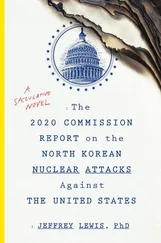We climb on board. The Pueblo’s foredeck is crawling with an assortment of Chinese tourists, North Korean actors in World War II sailor suits, and a chain-smoking crew of riggers and special-effects people, three of whom fan the flames of a smoke machine. In the middle of the chaos, Mr. Ri, in combat gear and gold aviators, is trying to direct. No one shuts up when he rolls: he’s not recording sound. “This ship invaded our territorial waters more than seventeen times,” a prim soldier-guide tells the tourists. “Our navy captured the captain and all the sailors. They killed two and the rest were imprisoned alive. The US government sent a letter of apology asking for their ship back. We sent back the prisoners, but not this ship, as it is our trophy.”
“Action!” shouts Ri over the guide, every inch the Commander of the Creative Group. A handsome North Korean marine grips a wheel on the main bridge, gazing over the curious tourists at an invisible flotilla of American frigates: “Seagull One to Seagull Two: we’re surrounded by enemy vessels!” he says into a two-way—and Ri throws down his cap in disgust. “What is wrong with you?” he barks. “You’re driving a battleship, not going for a walk on the beach! Calmness won’t cut it. You have to do it like this.” Ri lowers his glasses and delivers the lines with quiet machismo. “Again!” he yells, and the nervous actor redoes his take—as the smoke machine billows grey clouds all over the flash-bulbing Chinese. A camera assistant stands tip-toed on an apple box, coaxing smoke towards the actor’s face with a small blue hankie. It’s the sort of thing a Western gaffer might do if the high-tech gadgetry wasn’t delivering. We may operate sixty years in the future, but sometimes an old-fashioned hankie does the trick.
“In our movie, we show the confrontation between our marines and the bastard Americans. We won this confrontation. That’s the story,” Ri declares as his crew move gear around for the next setup. A dignified man in a white captain’s jacket waits beside me and Nic as gaffers rig up his lights. From the way the makeup ladies are fussing over him, he appears to be a movie star. We pick up our tripod to get out of the way, but Ri stops us, speaking fast. It sounds important—but Sun Hi is still too annoyed with us to translate. “Nicola, bwaaaaah gung ,” Ri declares urgently, making a panning motion with his hands. “Anna, ‘Okay! Yeah!’” Ri says to me, giving a thumbs-up. “Action!” he yells at his crew—and before we can work out what’s happened, we’re on camera. The captain speaks enthusiastically to Nic, and Ri’s lens points straight at my face. Nic pans, and I give the captain a hesitant, “Okay, yeah!”
“Cut!” Ri yells, and makes us do it again. His cinematographer, wearing a makeshift steadicam rig, is riveted by our digital Sony camera. He glides closer to Nic with each take, and by the fifth one, his softly whirring German Arri is making love to the Sony, the lenses so close to each other, the focus puller grazes Nic’s ear.
“Comrade Ri’s film is about the Pueblo , but it’s also about how people come from all over the world to see it,” says Sun Hi when we regroup under the gun turrets. She seems to have suddenly forgiven us for the gruelling events of the morning. She’s wearing her Team Gas cap again and is flushed with pride. Nic and I, after all, have just successfully starred in a movie by the great Ri Kwan Am. Apparently, the captain was telling us how the North Koreans captured the ship, and my “Okay, yeah!” was Ri’s idea of how an average Western media hack would react, when told such a heroic story.
Ri’s so pleased he’s granted us an interview. I meet him at the starboard gun ship, daunted. “Rule four says: Acting depends on the director ,” I begin, flipping open Kim Jong Il’s manifesto.
Ri cuts me off. “Yes, yes. Acting is in the hands of the director, I agree. In your film, there is an evil miner. The actor you’re using doesn’t look like a baddie. So don’t make him act evil. No one is that simple. Who would knowingly do a bad thing? He must genuinely think what he is doing is right.” I nod, struck by how completely this contradicts Kim Jong Il’s dictum that to play a bad guy, you must hate him with your very soul.
“Who are the foreign actors you’re using?” I ask Ri, pointing at three blond men on the mess deck. They stick out like sore thumbs, these strapping, blue-eyed boys sitting uneasily in their ill-fitting sailor suits as the makeup ladies powder their skin. They are doing everything possible to avoid my gaze.
“They are the Dresnok boys. They’re playing the Americans who pursued the vessel,” Ri says dismissively—and I realise with a shock that we’ve stumbled on the progeny of the famous Joe Dresnok, North Korea’s number-one movie villain. Dresnok snuck over the DMZ in the 1960s, along with Charles Robert Jenkins and two other American GIs, each soldier hoping to avoid punishment for misdemeanours they’d committed while stationed in the South. Dresnok’s naive plan was to escape through North Korea into the Soviet Union, where he hoped to start a new life. Instead, he and his comrades were snapped up by Kim Jong Il, installed in mud huts with North Korean concubines, and put to work: playing the evil enemy in almost every military movie he shot.
According to a book Jenkins wrote about their ordeal, the uneducated Dresnok was a bully who beat up the other GIs to gain favour with their captors. Perhaps because of this, he is the most celebrated foreign actor in North Korea and is recognised all over Pyongyang, where he still lives. With Dresnok now retired, Jenkins safely on Sado Island, and the other two GIs deceased, Dresnok’s sons are filling the ongoing demand for Yankee bad guys. They were born and raised North Korean, but their fair skin indicates their mother is Caucasian. I wonder if she was one of Kim’s kidnapped language teachers, or perhaps a dancer in his Joy Division—gifted to Dresnok in reward for his loyalty. I doubt that his sons are going to tell me—the murderous looks they’re sneaking our way, as if Nic and I are personally responsible for the two million civilians killed in the war, suggests they’ve had to be more North Korean than the North Koreans to survive.
“Currently we are telling the hundred-year history of American invasion. We’re telling the whole human race what happens in the end to invaders. We want to show who the real protector of happiness and justice is,” Ri says grandly to my camera, as the tourists gather round to watch. “In rule two, One must aim high in creation! , our Leader stresses you must start small, and end big, bam, with something magnificent,” Ri goes on. “Believe me, the audience will appreciate it. Also, it says here…” he riffles through the manifesto, looking for the page—but a loud Californian twang interjects: “I’m here to present $100,000 to get our ship back.”
Ri, the tourists, and the crew look round in surprise. A grey-haired man in crumpled chinos is lurching unsteadily towards us. “And every day you don’t give our ship back, we’ll have to lower our offer by $10,000,” he continues, giving our camera an imbecilic grin.
“Mr. Ri Kwan Am is a highly respected filmmaker and the director of this movie,” I admonish the heckler, feeling responsible for the anger and embarrassment of the North Koreans around me.
“Oh great, nice to meet you!” the man says to Ri, with a mock salute. He seems slightly drunk, or mentally unhinged. Or both. Ri doesn’t shake his hand, and the man doesn’t offer.
“As I was saying,” Ri says coldly, turning his back on the man and giving me an imperious stare, “in rule two —”
“And another thing!” the man calls out, photobombing Ri’s interview again. “We’re a believer in Jesus, and I hope you don’t mind me saying, the principle of forgiveness—that when we confess our sins and own up to what we’ve done, we’re forgiven—is a great way to live. Have a nice day!” He waves and stumbles off. Nic and I watch him go, gobsmacked. We thought North Korea was an American-free zone, until we boarded the Pueblo . In the last five minutes, we’ve seen four. I turn back to Ri, but he’s already walking away. “I need to shoot. We’ll chat later,” he says with quiet dignity, making a rolling motion with his fingers. His crew file behind him, stealing furtive glances at the flickering lights of the Sony.
Читать дальше
